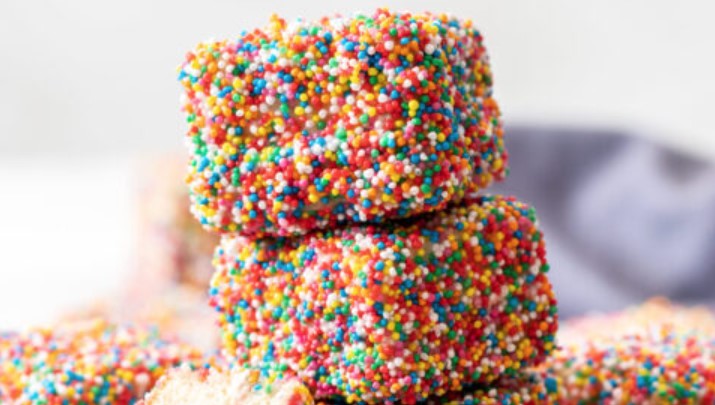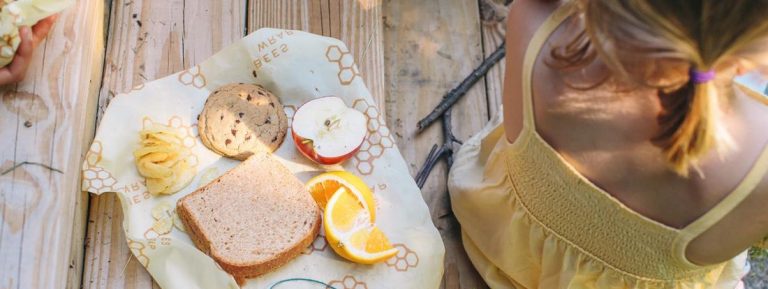When we cook privately with our colleagues during the lunch break or at the weekend, there are rarely leftovers. If a cup of rice or a portion of pasta has been made too much (for example, if the eyes of our dear colleague Steffi were bigger than her stomach…), the leftovers are of course packaged and stored in the fridge. But before that, the search for the right lid for the can begins. And if you can’t find it, a layer or two of cling film has ended up on the can, because it rarely really sticks with one.
In order to put a stop to the search for lids and the mountains of plastic waste, we tried out a great alternative: beeswax towels or in English Bee’s Wrap.
Benefits of Beeswax Wipes

Beeswax towels are made from a cotton muslin fabric covered with a layer of beeswax and jojoba oil. Sometimes tree resin is also mixed in. These raw materials, especially beeswax and jojoba oil, naturally have antibacterial properties and are therefore ideal for wrapping vegetables, fruit and cheese. The towels are very flexible in their handling and nestle well to any shape. At the same time, the wax gives them a certain strength, which keeps the Bee’s Wraps in the shape they are shaped into with warm hands.
The wipes can be used over and over again and have an amazing shelf life of up to 2 years. A really good alternative when you consider that a piece of cling film often ends up in the trash after less than 24 hours. After use, you can simply wipe them down with a cold, damp cloth and let them air dry.
Hot things
The all-rounder beeswax cloth is excellent at adapting to its surroundings. But even the cloths get too hot in some situations. We therefore advise against cleaning the towels with hot water, drying them on the heater or covering hot food with them. Even in summer in the sunlit car, the towels don’t like it. The heat melts the wax and the cloths can lose their function.
If they have gotten a little sunstroke, you should give them a rest and let them cool down before you continue to use them.
Caution! The cloth is not suitable for meat and sausage due to the limited cleaning options!
Buy beeswax wipes
Originally, the first towels came to us from the USA. But since we want to improve our CO2 balance with the reusable cloths, we think European manufacturers are the better choice. Finally you can also order Bee’s Wraps from us.
Beeswax towels DIY
In addition to buying the towels, you have the option of making them yourself. We tried it and after the 5th shawl we got the hang of it 😉
For the production you first need fabric remnants of pure cotton, old bed sheets, old T-shirts or pillowcases are suitable for this. The second most important thing is the beeswax, which can be ordered online as granules. You will also find what you are looking for in the local health food store, at the market or directly from the beekeeper. Good to know, by the way: Residue-free organic beeswax is also declared as such.
We also recommend that you buy a bottle of jojoba oil. We did without it in our first experiment and got very strong and partly brittle cloths.
When you have all the “ingredients” together, all that is missing is the tools consisting of an iron or an oven, baking paper, an old sheet and scissors. Then it can go!
Cut the leftover fabric to the desired size. For this you can z. B. measure typical doses. A size of 20 x 20 cm has proven itself for us. The cloths do not have to be re-stitched as the wax seals the edges.
Lay out the old sheet and set the iron to the cotton setting.
Now a layer of baking paper, the cloth, beeswax, a few drops of jojoba oil and another layer of baking paper are stacked.
Stroke the baking paper lightly with the iron and distribute the melting wax evenly.
The cloth is ready when it is evenly coated in wax on both sides. You can tell by a darker and yellowish color in light fabrics.
Carefully remove the parchment paper (caution: hot things). Often there are still beeswax residues stuck to the baking paper. These can be used for the next cloth.
You bought beeswax towels or made them yourself? Now you can start wrapping. The yoghurt bowl from breakfast, the individual lettuce leaves, half an onion, the individual rolls from the baker. The towels are versatile. At the beginning the adhesive feeling of the wipes is still very strong, this decreases a bit over time, but does not limit the function.
Already knew?

A large cloth, e.g. 30 x 30cm, is good for covering leftover cakes on a plate or for wrapping bread.
Beeswax wraps can also be used for things other than food. For example as rain protection for the bicycle basket. Just try it out.
Is your beeswax wrap no longer sticking so well? Hold it briefly under warm water or warm it with your body heat.











